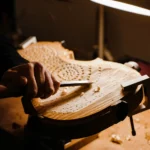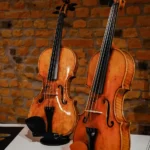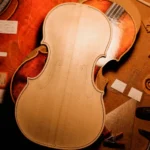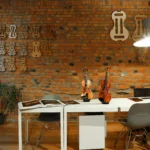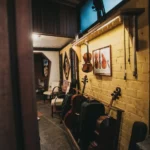History Of French Bow Making
Back to BlogHistory Of French Bow Making
If you are passionate about violins, then we are sure the history of French bow-making will excite you. French bow-making holds a revered place in the world of string instruments, renowned for its exquisite craftsmanship and artistic innovation. From the elegant curves to the meticulous selection of materials, French bows have captivated musicians and collectors for centuries. Understanding the rich history of French bow-making sheds light on the evolution of musical instruments and deepens appreciation for the mastery and tradition passed down through generations. In this blog, we explore the significance of French bow-making and why delving into its history is essential for anyone passionate about string instruments.
Pack your bags as we travel back to the 16th century and enter Mirecourt in France. Why specifically Mirecourt? It is because the art of bow-making commenced from that land. Read the following blog as we will discuss the development of the violin bow, prominent archetiers like Nicolas Pierre Tourte and François Xavier Tourte, and what material went into the bow’s construction.
Early French Bow-Making Tradition
French bow-making has deep roots dating back to the Renaissance period when craftsmen began producing bows for early string instruments like the viol and viola da gamba. Initially, French bow makers drew inspiration from English and Flemish traditions, incorporating elements of their craftsmanship into their own work. These early bows were often shorter and more curved compared to modern bows, reflecting the musical styles and instruments of the time.
The development of French bow makers, particularly François Xavier Tourte, was transformative for French bow making. François Tourte, known as the “father of the modern bow,” introduced significant innovations such as the stick’s convex curve and the use of Pernambuco wood. French artisans eagerly adopted Tourte’s techniques, refining and adapting them to create bows that were renowned for their balance, agility, and tonal qualities.
Paris emerged as a leading center for bow-making during the 18th and 19th centuries, attracting talented artisans from across France and beyond. Mirecourt, located in the Vosges region, also played a pivotal role in French bow-making, with numerous workshops producing bows of exceptional quality. Lyon, known for its vibrant musical culture, became another important hub for bow-making, contributing to the diversity and innovation within the French tradition. These centers fostered collaboration and competition among bow makers, driving continual refinement and innovation in French bow-making techniques and designs.
Mirecourt, France: The Home of French Bow-Making
Delving deeper into Mirecourt’s illustrious history as the birthplace of French bow-making, one cannot overlook the intriguing tale of the Pernambuco wood controversy. This narrative unfolds as a pivotal chapter in the saga of bow refinement, as this prized material became the cornerstone of bow manufacturing for the esteemed violin bow makers of Mirecourt.
The story begins in 1500 when Portuguese explorers stumbled upon the shores of Brazil, encountering trees along the coastline that held immense commercial potential. The discovery of Brazilwood sparked a flourishing trade between Brazil and Europe, with vast quantities of this precious wood being harvested and shipped across the Atlantic. This era coincided with the rise of master archetiers and luthiers in Mirecourt, establishing the city as a bustling hub of trade, ideas, and culture.
Fast forward to 1732, a pivotal year in Mirecourt’s history, as the local luthiers formed their guild, laying down stringent quality standards for instruments. These exacting measures provided violin makers with the impetus to hone their craft to perfection, captivating discerning buyers with their exceptional skill and craftsmanship.
As the 18th century unfolded, Mirecourt emerged as a prominent commercial center in France, fueled by its access to premium Pernambuco wood from Brazil. This coveted material became synonymous with the unparalleled quality of Mirecourt bows, further solidifying the city’s reputation as a bastion of excellence in bow-making.
Throughout this transformative period, bow-making art evolved from an anonymous craft to a revered discipline, with master bow-makers beginning to shine brightly on the global stage. Their expertise and dedication propelled Mirecourt to the forefront of the bow-making world, leaving an enduring legacy that continues to inspire artisans and musicians to this day.
French Bow-Making Techniques
Dominique Peccatte, François Xavier Tourte, and Louis Bazin contributed significantly to technique development, experimenting with different materials, designs, and methods to enhance the playability and sound of their bows. The transition from baroque to classical and then to romantic musical styles also influenced French bow-making, with artisans adjusting their techniques to accommodate changes in bowing techniques, articulation, and tonal preferences. As musical tastes continued to evolve into the 20th century, French bow makers embraced modern innovations while maintaining a deep respect for tradition. This ensured that French bows remained highly sought after by musicians worldwide.
Nicolas Pierre Tourte
Bow-making journey started with Nicolas Pierre Tourte (1700-1764). You will be surprised to know that he was a carpenter in the beginning. His workshop produced and sold both bows and instruments. He earned the title of becoming an innovator in the domain of bow-making.
Tourte’s bows were known for several key advancements. He moved away from traditional, heavy bows with convex fluted sticks and favored lighter wood and a more precisely proportioned design. A crucial addition was the introduction of a backward bend in the stick, a feature essential for optimal elasticity and responsiveness.
His influence extended beyond his own work. He is believed to have trained several apprentices who became renowned bowmakers themselves, including his son, François Xavier Tourte, who further refined his father’s designs.
Golden Age of French Bow-Making
The Golden Age of French bow-making, spanning roughly from the late 18th to the early 19th century, marked a pinnacle of craftsmanship and innovation in the field. During this period, iconic French bow makers and workshops emerged, garnering international acclaim for their exceptional quality and precision. Artisans such as François Xavier Tourte, Dominique Peccatte, and Jean Pierre Marie Persoit rose to prominence, establishing workshops that became synonymous with excellence in bow making.
Bows from the golden age are characterized by their exquisite craftsmanship, meticulous attention to detail, and impeccable balance. François Xavier Tourte, often hailed as the “Stradivarius of the bow,” revolutionized bow design with his convex curve and innovative use of materials such as pernambuco wood and silver mounts. Dominique Peccatte, known for his robust and powerful bows, perfected the art of balance, producing bows prized for their responsiveness and projection. Jean Pierre Marie Persoit, a master of precision, crafted bows admired for their elegant lines and refined aesthetics.
Each of these notable bow-makers made significant contributions to the advancement of bow-making techniques and design. Tourte’s convex curve design, Peccatte’s robust and flexible sticks, and Persoit’s meticulous craftsmanship set the standard for bow-making for generations to come. Their bows became prized possessions of renowned musicians and collectors alike, revered for their exceptional playability and tonal qualities.
The Golden Age of French bow-making represents a pinnacle of artistic achievement, showcasing the ingenuity, skill, and dedication of master artisans. Today, bows from this era remain highly coveted and cherished for their historical significance and unparalleled craftsmanship.
At Amorim Fine Violins Cremona, we invite you to explore our collection of antique French bows, meticulously curated to celebrate French bow-making’s timeless artistry and heritage. Each bow tells a story of craftsmanship and tradition, waiting to be discovered by discerning musicians and collectors alike. Embrace history, embrace excellence, and explore our collection today.





